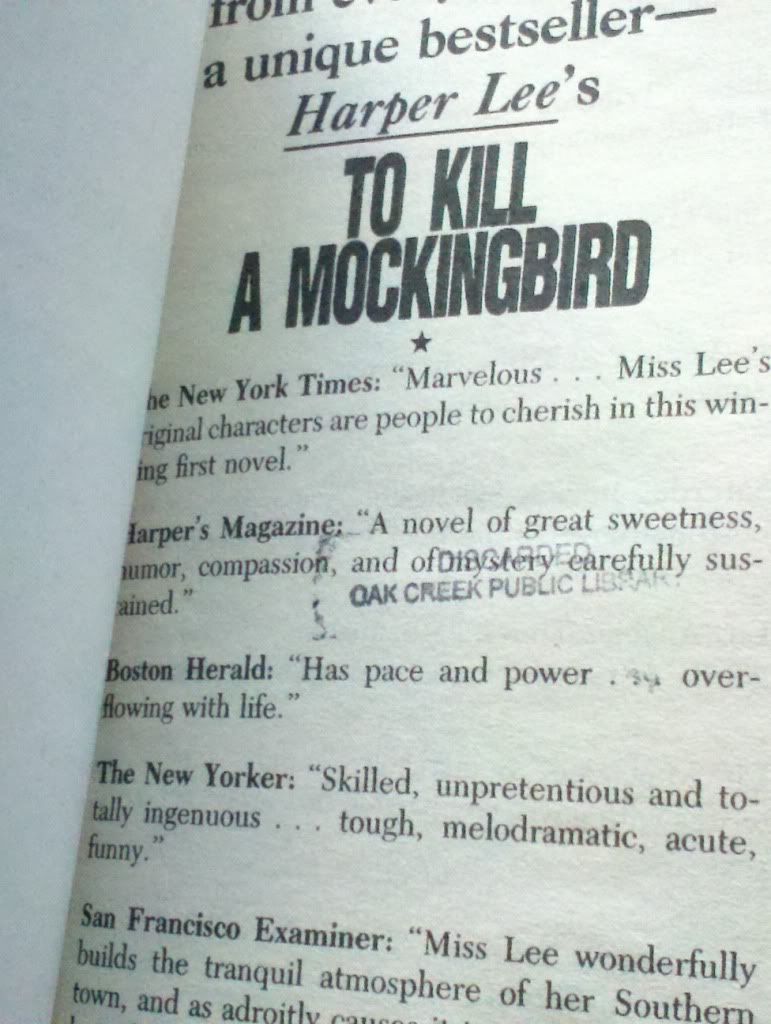We finally have sunshine here after days of rain. Six to be exact. Not quite forty as Noah had to contend with. I don't have to go get any Ark-building supplies. Everything is still pretty soggy. Oh yeah, To Kill a Mockingbird.
Here's an overview of the story:
In the small town of Maycomb, Alabama, in the 1930s, six-year-old Scout Finch and her older brother Jem become the beneficiaries of gifts left by an anonymous giver who deposits them in the hollowed tree outside the Radley house. While Scout and and Jem ponder the identity of their generous secret sharer and his relationship to the reclusive Radley family, their lawyer father, Atticus, is appointed defense attorney for Tom Robinson, a young black man accused of raping a white woman in a case that has brought the town's simmering racial tensions to a boil. Slowly, ineluctably, the worlds of innocence and experience known to the members of the Finch family come into violent collision, shaking their beliefs in the inevitability of justice and the ultimate triumph of truth over hypocrisy and prejudice.To Kill a Mockingbird by Harper Lee is one of my favorite books. It's also one of the most frequently challenged classics. From ala.org:
A modern American classic that won the Pulitzer Prize for fiction in 1961 and served as the basis for the Academy Award-winning film starring Gregory Peck, Harper Lee's To Kill a Mockingbird has never been out of print in the more than half-century since it was first published.
Challenged in Eden Valley, MN (1977) and temporarily banned due to words "damn" and "whore lady" used in the novel. Challenged in the Vernon Verona Sherill, NY School District (1980) as a "filthy, trashy novel." Challenged at the Warren, IN Township schools (1981) because the book does "psychological damage to the positive integration process" and "represents institutionalized racism under the guise of good literature." After unsuccessfully trying to ban Lee's novel, three black parents resigned from the township human relations advisory council. Challenged in the Waukegan, IL School District (1984) because the novel uses the word "nigger." Challenged in the Kansas City, MO junior high schools (1985). Challenged at the Park Hill, MO Junior High School (1985) because the novel "contains profanity and racial slurs." Retained on a supplemental eighth grade reading list in the Casa Grande, AZ Elementary School District (1985), despite the protests by black parents and the National Association for the Advancement of Colored People who charged the book was unfit for junior high use. Challenged at the Santa Cruz, CA Schools (1995) because of its racial themes. Removed from the Southwood High School Library in Caddo Parish, LA (1995) because the book's language and content were objectionable. Challenged at the Moss Point, MS School District (1996) because the novel contains a racial epithet. Banned from the Lindale, TX advanced placement English reading list (1996) because the book "conflicted with the values of the community." Challenged by a Glynn County, GA (2001) School Board member because of profanity. The novel was retained. Returned to the freshman reading list at Muskogee, OK High School (2001) despite complaints over the years from black students and parents about racial slurs in the text. Challenged in the Normal, IL Community High School's sophomore literature class (2003) as being degrading to African Americans. Challenged at the Stanford Middle School in Durham, NC (2004) because the 1961 Pulitzer Prize-winning novel uses the word "nigger." Challenged at the Brentwood, TN Middle School (2006) because the book contains “profanity” and “contains adult themes such as sexual intercourse, rape, and incest.” The complainants also contend that the book’s use of racial slurs promotes “racial hatred, racial division, racial separation, and promotes white supremacy.” Retained in the English curriculum by the Cherry Hill, NJ Board of Education (2007). A resident had objected to the novel’s depiction of how blacks are treated by members of a racist white community in an Alabama town during the Depression. The resident feared the book would upset black children reading it. Removed (2009) from the St. Edmund Campion Secondary School classrooms in Brampton Ontario, Canada because a parent objected to language used in the novel, including the word “nigger."For the last day of banned books week, and because I was able to pick up a nice, gently read copy yesterday. I want one of you to have it. There's no writing, highlighting, or dog-eared pages. The only flaw I noticed was a small library discard stamp that you can see in the photo below. The cover shows light shelf wear with NO spine-creasing. Here are the photos:
If you're interested in having this book, just say so in the comments. Anonymous comments will not be counted. I'll select a winner randomly, and announce it Monday at noon Central time.
Happy reading,
Angela




of coarse i'm interested , books r sparce here
ReplyDelete